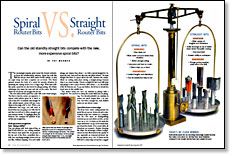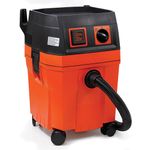Spiral Router Bits vs. Straight Router Bits
Can the old standby straight bits compete with the new, more expensive spiral bits?
Synopsis: Pat Warner compares the qualities of spiral bits and straight bits. Both have “plunge-ability,” but spiral bits leave a cleaner edge; straight bits come in many sizes and bearing configurations. Sharpening spiral bits is difficult, if not impossible, and they can be risky to use. Warner says there’s no clear winner; you must pick the best bit for the job, and this article helps clarify which bit is better for different applications. Side information tells you how to distinguish an upcut bit from a downcut bit.
The increasingly popular spiral router bits borrow technology from the metalworking industry. Spiral bits look like drill bits and are most often made of solid carbide, so they are super sharp and leave a superior cut on wood. Two flutes ground around the body of a spiral bit smooth vibration by spreading the cutting action over a longer edge. With their drilllike point, spiral bits are also better for plunge-cutting. All of these advantages also mean less wear and tear on the router. But don’t throw out all of your old straight bits just yet.
The new solid-carbide spiral bits come with some disadvantages. The first is that the cutters are expensive. A typical solid-carbide spiral bit is likely to cost at least $50. A similarly sized straight bit with carbide-tipped cutters will run somewhere in the range of $7 to $23. With a cost differential that large, you will want to know what you are going to do with this bit and that you will use it often enough to get your money’s worth. To highlight other differences, let’s compare the qualities of spiral bits and straight bits.
Both spiral and straight bits have “plunge-ability”
You can plunge with both types of bits, so they’ll both work for, say, cutting mortises. But because most spiral bits are ground on the tip end of the flute, somewhat like a drill, you can plunge straight down as far as you like, without stopping. You can’t really plunge any deeper than about in. with a typical straight bit. Inspect the end, and you’ll see why. On most straight bits there is a space above the web, between the cutters, where no cutting takes place during a straight plunge because there is no cutter overlap. Chuck a straight bit into your drill press and plunge it into a piece of wood. After about in., the middle of the bit bottoms out. To go any farther, the bit has to abrade the wood away in this middle area.
This doesn’t mean you can’t cut mortises or plunge with a straight bit. You just have to sweep the router while you are plunging. You should probably cut mortises in passes not much deeper than in. anyway, but with a straight bit, such shallow passes are just about a must.
Spiral bits leave a clean edge
The three basic cutter configurations for spiral bits are up-cut, down-cut and a combination of the two, known as a compression bit. A down-cut bit sends the chips downward; an up-cut bit sends them up toward the shank. (On a router table, all directions are reversed.) Besides directing the chips, the advantages of these configurations are best illustrated by the quality of cut, especially on veneered plywood.
From Fine Woodworking #140
For the full article, download the PDF below:
Fine Woodworking Recommended Products

Fein Turbo II HEPA Wet/Dry Dust Extractor

Stanley Powerlock 16-ft. tape measure

Festool DF 500 Q-Set Domino Joiner





















Log in or create an account to post a comment.
Sign up Log in